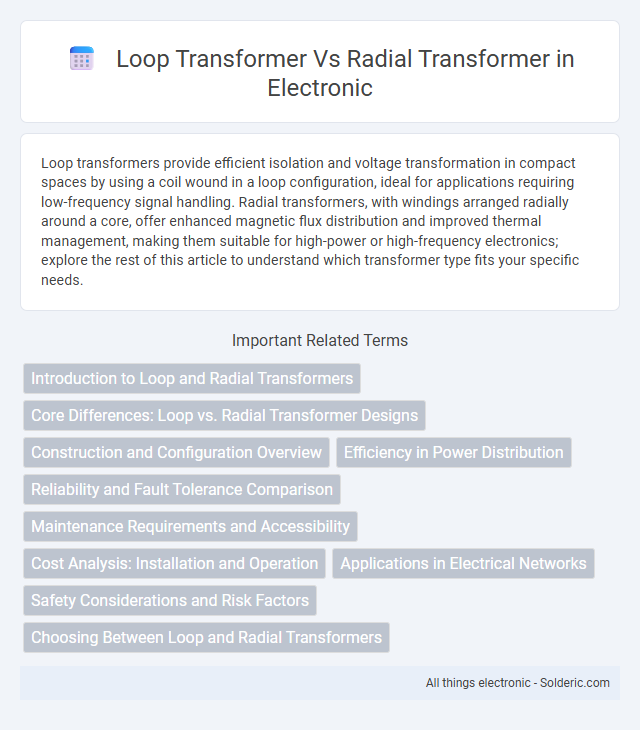Loop transformers provide efficient isolation and voltage transformation in compact spaces by using a coil wound in a loop configuration, ideal for applications requiring low-frequency signal handling. Radial transformers, with windings arranged radially around a core, offer enhanced magnetic flux distribution and improved thermal management, making them suitable for high-power or high-frequency electronics; explore the rest of this article to understand which transformer type fits your specific needs.
Comparison Table
| Feature | Loop Transformer | Radial Transformer |
|---|---|---|
| Architecture | Utilizes looping multi-pass attention to refine representations | Employs radial attention focusing on hierarchical token relations |
| Attention Mechanism | Loop-based iterative attention updates | Radial attention with spatially structured focus |
| Token Interaction | Repeatedly revisits tokens for enhanced context | Aggregates tokens radially based on position |
| Computational Efficiency | Higher computation due to multiple attention loops | More efficient by limiting attention to radial neighbors |
| Use Cases | Complex sequence modeling needing iterative refinement | Hierarchical or spatial data modeling |
| Strengths | Improved representation with iterative attention | Efficient context aggregation with spatial hierarchy |
| Weaknesses | Increased latency and resource consumption | Potentially limited by fixed radial structure |
Introduction to Loop and Radial Transformers
Loop transformers feature a closed-loop magnetic core that ensures efficient flux circulation, minimizing losses and enhancing voltage regulation in electrical circuits. Radial transformers, on the other hand, distribute electrical power radially from a central point, making them ideal for applications requiring multiple branch connections with stable voltage levels. Choosing your transformer depends on the specific load distribution and system topology, with loop designs favored for compact, continuous flux paths and radial types suited for branching power delivery systems.
Core Differences: Loop vs. Radial Transformer Designs
Loop transformers feature a closed-loop core that facilitates continuous magnetic flux circulation, enhancing efficiency and reducing leakage inductance compared to radial transformers, which have a core structure radiating outward from the center. Radial transformer designs typically prioritize simplified winding arrangements and compact size, but they may experience higher flux leakage and lower coupling efficiency relative to loop transformers. These fundamental structural differences impact performance characteristics such as voltage regulation, thermal management, and electromagnetic interference in various electrical applications.
Construction and Configuration Overview
Loop transformers feature a toroidal core with a continuous winding that forms a closed magnetic loop, enhancing magnetic coupling and reducing electromagnetic interference. Radial transformers employ multiple windings arranged radially around a central core, optimizing space and providing efficient heat dissipation during operation. Your choice between these configurations affects the transformer's performance, size, and suitability for specific electrical applications.
Efficiency in Power Distribution
Loop transformers enhance efficiency in power distribution by providing a continuous path for current flow, reducing voltage drops and minimizing power losses in meshed networks. Radial transformers, designed for single-direction power flow, often experience higher losses during peak loads due to limited redundancy and longer feeder lengths. Optimizing power distribution relies on leveraging loop transformers in urban grids to improve reliability and energy efficiency.
Reliability and Fault Tolerance Comparison
Loop transformers offer enhanced reliability by providing continuous current paths, minimizing the risk of total failure during a fault. Radial transformers, while simpler and cost-effective, present lower fault tolerance as a single point of failure can interrupt the entire power flow. Your choice between these transformers should consider the critical importance of uninterrupted service and resilience in your specific application.
Maintenance Requirements and Accessibility
Loop transformers typically require less frequent maintenance due to their simpler design and direct connection, allowing easier access for routine inspections and repairs. Radial transformers, with branches extending from a single source, often need more regular monitoring to detect faults along individual feeders, complicating accessibility. Maintenance strategies for loop transformers benefit from their inherent redundancy, while radial systems rely heavily on quick response times to localized issues.
Cost Analysis: Installation and Operation
Loop transformers typically incur higher installation costs due to complex wiring and infrastructure requirements, but their operation is efficient in stable load environments. Radial transformers offer lower initial installation expenses and simpler setup, making them cost-effective for smaller or less complex systems, though operational costs may increase with load variability. Your choice should consider long-term operational efficiency against upfront investment to optimize overall expenditure.
Applications in Electrical Networks
Loop transformers are primarily used in railway signaling and traction power systems, enabling isolation and voltage transformation in looped feeder circuits. Radial transformers are commonly deployed in distribution networks where power flows in a single direction from the substation to the load, optimizing voltage regulation and reducing losses. Electrical networks benefit from loop transformers in enhancing system reliability and fault detection, while radial transformers support straightforward load management and simpler network designs.
Safety Considerations and Risk Factors
Loop transformers provide inherent safety benefits by isolating electrical circuits and limiting fault currents, reducing the risk of electric shock or equipment damage. Radial transformers, while simpler in design, can present higher risk factors due to their direct feed arrangement, which may propagate faults through the network and increase potential hazards. Proper installation, grounding, and regular maintenance are critical in both transformer types to mitigate risks and ensure safe operation within electrical systems.
Choosing Between Loop and Radial Transformers
Choosing between loop and radial transformers depends largely on the network configuration and reliability requirements. Loop transformers provide continuous power supply by feeding the system from two directions, minimizing outage risks in critical areas, while radial transformers are simpler and cost-effective for straightforward, small-scale distribution systems with less critical load demands. Consider load density, fault tolerance, and maintenance complexity when selecting the appropriate transformer type for optimal grid performance.
loop transformer vs radial transformer Infographic

 solderic.com
solderic.com